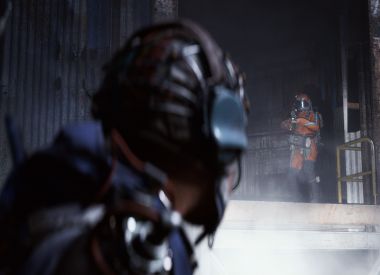Starbreeze Studios unveiled a prototype for their virtual-reality headset at E3 2015. The Star VR is one of few VR headsets in-development that hopes to lead the market one day with their new technology.
iDigital Times spoke to Almir Listo, global brand director for Starbreeze Studios and producer of Overkill’s The Walking Dead game, about the company’s in-development VR headset. What makes Star VR unique from other VR headsets coming out to the market soon is the screen will give you peripheral vision.
“The big points that for anyone that hasn’t tried VR before, is that many other headsets only have 100-degree vision so it’s very slim. But [Star VR] opens up 210 degrees so that you’ll have the peripheral vision. You see much more- about 75 percent of the human vision. That gives you total immersion,” Listo said.
Peripheral vision is an important part of combating the motion sickness some users experience with VR headsets, according to Listo. Opening the field of vision allows the user to make slower movements with their head. For example, you can look out the side of your eye to see if a zombie is coming at you in The Walking Dead demo instead of jerking your head left or right.
“You don’t have to turn and twist your head that much anymore because you see so much already. Your head can stay still,” Listo said. “With other headsets you need to turn around in order to see...and that can cause additional motion sickness that you might not experience with [Star VR].”
Another aspect that sets Star VR apart from other headsets is its tracking technology. The Walking Dead demo used a remote shotgun for players to use with the game. A tracker was placed on top of the shotgun to monitor its movements. For example, if the player moved the gun to their left in real life, the gun would move left in the game. Listo explained the company wants to fully immerse their users in their virtual world.
“Those are trackers that you can put on different peripherals,” Listo said. “The trackers are read by the camera on the headset and it allows you to see the peripheral in the game. For example, in [The Walking Dead] demo we have a physical shotgun- you can see that shotgun in the demo. You’re holding the [gun] in reality and it [moves with you] in the virtual reality world.”
Unfortunately, the virtual reality experience using Overkill’s The Walking Dead showcased at E3 2015 was a demo used to reveal the capacity of Star VR’s technology. The good news for The Walking Dead fans is they’ll be able to eventually experience the Overkill’s first person shooter when it hits the PlayStation 4, Xbox One and PC.
“We’re excited [for Star VR] because there are so few contenders out there [for VR headsets] and we’re one of them,” Listo said. “We think that our headset is very, very good in comparison to many others out there.”
We had the opportunity to test out the Star VR prototype with Overkill’s The Walking Dead demo. Check out our thoughts about the VR headset and the game here.


















